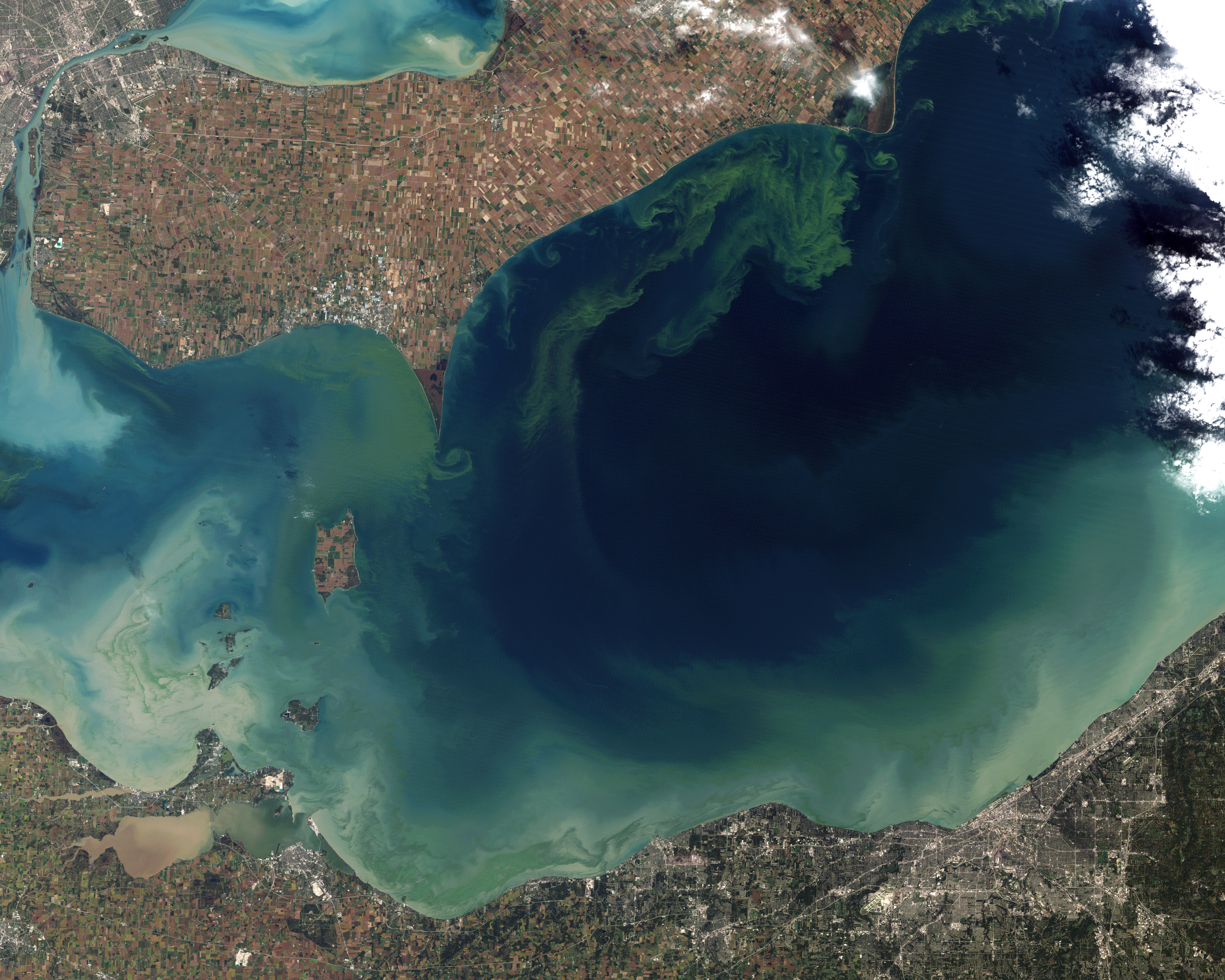
Algae from fertilizer runoff chokes Lake Erie. Photocredit: NASA, Jesse Allen, and Robert Simon
In 2011 Lake Erie turned green. A massive algae bloom covered the water, blocking sunlight, starving aquatic plants, and producing liver toxins, which posed a threat to human health. A similar event in 2014 deprived 500,000 Toledo, Ohio residents of drinking water for three days. Lifeguards have reportedly gotten sick from exposure to the water, and some people are starting to wonder if lake’s paint-like green goop will hurt the local tourism industry and are asking visitors to plan their vacations around the location of the algae blooms. All signs point to the algae blooms getting worse over time. The cause was the phosphorus in the artificial fertilizer used in conventional agriculture.
Phosphorus is element number fifteen on the periodic table, and nowhere near the first thing on most peoples’ minds. We all depend on phosphorus, because phosphorus is part of DNA. Usually, phosphorus recycles naturally in a biological system as plants take up phosphorus from the soil, animals eat the plants, and then excrete the phosphorus back into the soil. Most of the phosphorus available in a natural system comes from another living things, and phosphorus-rich rocks slowly wear down, adding back whatever phosphorus might be lost. However, human phosphorus mining has made unprecedented amounts of phosphorus available to biological systems, and those systems often can’t keep up. Since WWII, fertilizer use has increased drastically in an attempt to keep up with population growth. This new reliance on artificial fertilizers changed the face of agriculture, and led to some unexpected problems. When too much phosphorus accumulates in a pond, lake, or other large body of water, it sets off a process called eutrophication. During eutrophication, algae use the excess phosphorus to grow rapidly, which causes the algae to take up resources like oxygen more quickly than they otherwise would. In extreme examples, the algae can take up so much oxygen that fish can no longer live in the pond or lake.
So, what to do about it? The strategy will depend on the history of the specific catchment: the land area that drains into a given body of water. Many past attempts at managing catchments have not been as successful as managers had hoped. A summary paper written by people from a number of institutions including the Lancaster Environment Center and the Centre for Ecology and Hydrology tried to make sense of global phosphorus management by placing catchments into three categories. Their hope was that these categories would help managers close the gap between phosphorus need and phosphorus availability, so that excess phosphorus won’t run off. The first category describes equilibrium, with inputs and outputs being roughly the same. This group requires no management. The second type of catchment has higher inputs than outputs, and accumulates phosphorus. The amount of phosphorus in these cases can outstrip the local plant-life’s ability to absorb it. Managers of this type of catchment should focus on avoiding increased inputs of phosphorus. The final type loses phosphorus over time, since outputs are greater than inputs. According to the article, managers of these catchments should focus on limiting phosphorus loss, and promoting a cycle, instead of increasing the phosphorus inputs.
Intervention details would of course depend on the specific location, and a number of factors contribute to Lake Erie’s phosphorus load. For example, while low-tillage farming, while usually a good idea, may contribute to the problem when combined with high phosphorus inputs. In high-tillage farming, farmers work the fertilizer into the soil, while in low-tillage farming, farmers apply fertilizer to the surface where it can easily run off. The low tillage farming was an environmental policy put in place to help avoid erosion. While this policy would usually conserve soil resources, the huge phosphorus inputs undermine the purpose of the technique. Whether this policy can remain in place without destroying the lake is still uncertain. Climate change speeds the problem, since warm temperatures promote increased algae growth, and changes in the patterns of spring rains wash more phosphorus into the lake. In addition, after phosphorus gets into a lake, it can be hard to reverse the damage, even if no more phosphorus is added, since biological processes take over and the same phosphorus gets cycled over and over again in the lake ecosystem.
Lake Erie has a long way to recover, and as climate change washes the surrounding farmland with ever-larger spring storms and sweeps ever-larger loads of phosphorus into the lake, algae blooms may only get worse, and the people and animals that depend on Lake Erie will only suffer more in the future if a solution isn’t found. And since agricultural runoff is the primary source of phosphorus draining into the lake, this question is firmly tied to the amount and kinds of food the farmers can grow and what techniques and materials they use in the process. Can the residents of the Lake Erie catchment produce the right amount of food without poisoning the lake? The answer may be that they’ll have to.